Q1. Which one of the following does not act as a neurotransmitter?
Solution
Cortisone is a hormone released by the adrenal glands.
Q2. Nodes of Ranvier are found in
Solution
Nodes of Ranvier are found in myelinated nerve fibres. These are the gaps between two adjacent myelin sheaths.
Q3. The area where the medullary sheath is absent in the nerve fibre is called
Solution
The area where the medullary sheath is absent in the nerve fibre is called Node of Ranvier. These are the gaps between two adjacent myelin sheaths.
Q4. Distinguish between the yellow spot and
the blind spot.
Solution
Yellow Spot
Blind Spot
It
is located lateral to the blind spot at the posterior pole of the eye.
Blood
vessels enter and the optic nerve leaves the eye at this spot.
Cone
cells are densely packed in this region.
Photoreceptor
cells, i.e. rods and cones, are absent.
It
is the region of sharpest vision.
No
vision is formed at the blind spot.
Q5. State the significance of pinna.
Solution
Pinna collects vibrations from the
surroundings to generate sound.
Q6. Nerve cells do not divide because they
do not have
Solution
Nerve cells do not divide because they
do not have a centrosome which helps in cell division by forming microtubule-organising
centres.
Q7. Mark the vitamin present in Rhodopsin
Solution
Rhodopsin, a visual purple pigment, is a
derivative of vitamin A.
Q8. One of the examples of the action of the
autonomous nervous system is
Solution
Peristalsis of the intestines is an
example of the autonomous nervous system as it is an involuntary activity of
the body and is not according to the will of an organism.
Q9. Which cells are responsible for the
twilight or scotopic vision?
Solution
Rods
Q10. The purplish red pigment rhodopsin contained
in the rod type of photoreceptor cells of the human eye is a derivative of
Solution
Rhodopsin, a visual purple pigment, is a
derivative of vitamin A.
Q11. Study the following figure and name A,
B, C and D.
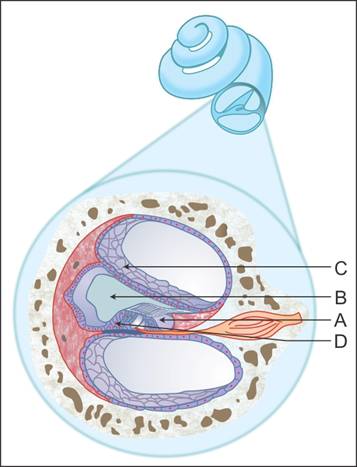

Solution
A - Tectorial membrane
B - Scala media
C - Reissner’s membrane
D - Organ of Corti
Q12. Nissl’s granules are present in
Solution
Nissl’s granules are present in the
cytoplasm of the cell body and the dendrites of the neuron.
Q13. Colour blindness is due to a defect in
Solution
Colour blindness is the inability to see colours. Lack of one or more types of cone cells causes colour blindness.
Q14. Iris is part of
Solution
The iris consists of two layers—outer one in continuation
with the choroid and inner one in continuation with the retina.
Q15. Name the external layer of the eyeball.
Solution
Sclera
Q16. Name the gap which exists between
pre-synaptic and post-synaptic neurons.
Solution
Synaptic cleft
Q17. Corpora striata occur in
Solution
Corpora striata is present in the ventrolateral walls of the cerebral hemisphere.
Q18. Colour perception in man is due to
Solution
Colour perception in man is due to iodopsin pigment in cone cells. In the retina, there are three types of cones which respond to red (erythropsin), green (chloropsin) and blue light (cyanopsin). Other colours are detected by simultaneous stimulation of more than one type of cone cell.
Q19. In human brain, the corpus callosum connects
Solution
Two cerebral hemispheres are interconnected by a thick band of transverse nerve fibres called the corpus callosum.
Q20. The human hindbrain comprises three
parts, one of which is the
Solution
Cerebellum, pons and medulla oblongata
are the three parts of the hindbrain.
Q21. Which part of the nervous system
controls the reflex activity of the body?
Solution
The spinal cord controls the reflex
activity of the body as it is a spontaneous automatic response to a stimulus.
So, it reduces the work load of the brain.
Q22. State the function of the ear ossicles.
Solution
Ear ossicles increase the efficiency of
the transmission of sound waves to the inner ear.
Q23. Chemicals which are released at the
synaptic junction are called
Solution
Neurotransmitters are the chemicals
released from a presynaptic neuron which interact with specific receptor
sites of a postsynaptic neuron.
Q24. Study the figure given below. Identify
A, B, C and D.
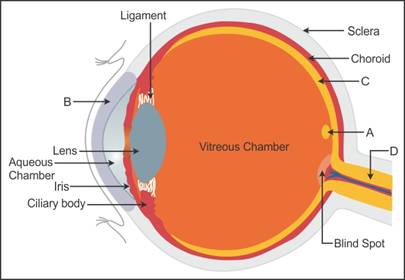

Solution
A - Fovea
B - Cornea
C - Retina
D - Optic nerve
Q25. The myelin sheath is derived from
Solution
In myelinated nerve fibres, the myelin sheath is derived from Schwann cells. It is present around the axon.
Q26. Which layer of the eyeball contains more
number of blood vessels?
Solution
Choroid layer
Q27. The wax gland present in the ear canal
is called
Solution
Wax glands present in the ear canal are
called sebaceous glands or ceruminous glands. They secrete a brownish,
semisolid, fatty substance called wax or cerumen.
Q28. Telescopic vision is found in
Solution
Telescopic vision is found in birds,
i.e. they have the ability to see distant objects clearly.
Q29. How many pairs of spinal nerves are
there in man?
Solution
There are 31 pairs of spinal nerves in
man. These are classified into five groups:
Cervical
nerves - 8 pairs
Thoracic
nerves - 12 pairs
Lumbar
nerves - 5 pairs
Sacral
nerves - 5 pairs
Coccygeal
- 1 pair
Q30. The thermoregulatory centre in the body
of a homeothermal animal and man is found in the
Solution
The thermoregulatory centre is found in
the hypothalamus of a homeothermal animal and man. It maintains homeostasis, i.e.
it regulates the temperature of the body.
Q31. The mammalian brain differs from an
amphibian brain in possessing
Solution
The mammalian brain has a corpus
callosum which an amphibian brain does not possess. The corpus callosum is a
large, curved tract of myelinated axons present at the bottom of the cerebral
hemispheres.
Q32. The electrical potential difference
between outside and inside of a nerve axon before excitation is known as
Solution
The electrical potential difference
across the resting plasma membrane is called a resting potential.
Q33. The autonomic nervous system affects
Solution
The autonomic nervous system controls the functioning of involuntary visceral organs. It is formed of the sympathetic nervous system and the parasympathetic nervous system. Both these systems are antagonistic to each other.
Q34. The corpus callosum is formed between
two
Solution
The corpus callosum is a large, curved
tract of myelinated axons present at the bottom of the cerebral hemispheres.
Q35. Where in the neural system are the
multipolar neurons found?
Solution
Cerebral cortex
Q36. The sensitive pigmented layer of the eye is
Solution
The retina consists of a pigmented layer and a
nervous tissue layer.
Q37. Name the system which transmits impulses from the central neural system to the skeletal muscles.
Solution
Somatic neural system
Q38. The supporting and nutritive cells found in the brain are
Solution
Astrocytes are star-shaped glial cells present in the brain. These are supporting and nutritive cells and also maintain ionic balance in the brain.
Q39. Name the membrane present above the hair
cells in the cochlea.
Solution
Tectorial membrane
Q40. Name the fluid present outside the
membranous labyrinth.
Solution
Perilymph
Q41. Which of the cells are phagocytic as well as scavengers?
Solution
Astrocytes, oligodendrocytes and microglia are three types of neuroglia. Astrocytes provide mechanical support to the neurons. Oligodendrocytes form myelin sheaths around the axon and microglia are phagocytic and scavengers. They engulf microbes and cellular debris.
Q42. Name the visible coloured portion of the
eye.
Solution
Iris
Q43. Which part of the brain controls
intellectual ability?
Solution
In the frontal lobe of the cerebral
hemisphere, thoughts and actions are monitored and creative ideas occur, so
it controls all intellectual ability.
Q44. One of the following examples of an action of the autonomic nervous system is
Solution
Peristalsis of intestine is an example of an action of the autonomic nervous system (ANS). ANS controls the function of visceral organs.
Q45. Where are the non-myelinated neurons present in the neural system?
Solution
Autonomic and somatic neural systems
Q46. Name the two membranes of cochlea.
Solution
The two membranes of the cochlea are Reissner’s
and basilar membranes.
Q47. Acute vision is present in
Solution
Acute vision is found in birds like vulture.
Q48. What is reflex action? Explain the
reflex pathway.
Solution
An involuntary response on stimulation of
the peripheral nervous system which requires the involvement of a part of the
central nervous system is called reflex action.
The afferent neuron receives a signal
from a sensory organ.
It then transmits the impulse to the
spinal cord via the dorsal root.
The spinal cord sends the processed signal
to the effectors through the efferent neuron forming a reflex arc.
Q49. The junction between the axon of one
neuron and the dendrite of the next is called
Solution
The junction between the axon of one
neuron and the dendrite of the next is called a synapse. Depending on the
nature of transfer of information, there are two types of synapses - chemical
synapses and electrical synapses.
Q50. Name the ions to which the axonal
membrane is more permeable during the resting potential.
Solution
Potassium ions
Q51. Which one of the following pairs of
structures distinguishes a nerve cell from other types of cells?
Solution
Perikaryon and dendrites are present in
a neuron. Perikaryon is a cytoplasm surrounding the nucleus. Dendrites are
shorter, tapering and branched processes present in the cell body.
Q52. Describe the structure of a neuron.
Solution
Structure of neuron:
Neuron is composed of cell body,
dendrites and axon.
The cell body contains cytoplasm. The cytoplasm
consists of Nissl’s granules which are also present in dendrites.
Dendrites are the short cytoplasmic
branches given out by the cell body. Dendrites carry nerve impulse towards
the cell body.
Axon is the longest process given out by
the cell body.
In case of myelinated neuron, axon is
covered with a myelinated sheath formed by Schwann cells.
The gap between the two adjacent
myelinated regions is called Node of Ranvier.
The distal end of the axon called axon-terminal
has bulb like structures call synaptic knobs which contain neurotransmitters.
Q53. Retina is most sensitive at
Solution
Macula lutea is a small area on the retina which
lies opposite to the optical axis of the lens. It has a depression (the fovea
centralis) in the middle. It is the area of most distinct day vision.
Q54. State the three types of neurons on the
basis of number of axons and dendrites present. Also, state the number of
axons and dendrites present and their location in the neural system.
Solution
The three types of neurons on the basis
of number of axons and dendrites are
Multi-polar
neuron
Bipolar
neuron
Unipolar
neuron
Multi-polar
neuron: It has one
axon and two or more dendrites. It is found in the cerebral cortex.
Bipolar neuron:It has one axon and one dendrite. It is found
in the retina of the eye.
Unipolar neuron: It has a cell body with only one axon. It is
found during embryonic development.
Q55. Name the ossicle which is attached to
the oval window.
Solution
Stapes is attached to the oval window.
Q56. Nissl's granules are absent in the
Solution
The cyton and dendrites contain Nissl's granules. The axon does not have Nissl's granules. In myelinated nerve fibres, Schwann cells form a myelin sheath around the axon.
Q57. The Nissl's granules of nerve cell are made up of
Solution
Nissl's granules are the groups of ribosomes and rough endoplasmic reticulum. They are involved in synthesis of proteins.
Q58. What is the organ of Corti?
Solution
The organ of Corti comprises the
structures which are present on the basilar membrane of the cochlea and which
bear auditory receptor hair cells.
Q59. The decoding and interpretation of visual information are carried by the
Solution
The cerebral hemisphere is divided into four lobes - anterior frontal lobe, middle parietal lobe, posterior occipital lobe and lateral temporal lobe.
The decoding and interpretation of visual information, shape and colour are carried by the occipital lobe.
Q60. Which of the following is not involved
in knee-jerk reflex?
Solution
The brain is not involved in the knee jerk
reflex action as it is a spontaneous, automatic mechanical response to a
stimulus without the will or thinking, of an organism.
Q61. State the name of the anterior thick part of the choroid layer.
Solution
Ciliary body
Q62. Name the pigment present in rod cells
Solution
Rhodopsin (visual purple)
Q63. Where is the vitreous chamber present?
Solution
The vitreous chamber is present between
the lens and the retina.
Q64. The sense of smell is perceived by
Solution
The anterior part of the brain is formed
by a pair of short club-shaped structures, the olfactory lobes. Olfactory
lobes are concerned with the sense of smell.
Q65. Which of the following nerves is purely a motor nerve?
Solution
Abducens is a motor nerve which controls the movement of the eyeball. Vagus, facial and trigeminal are mixed nerves.
Q66. Name the region in the eye where the photoreceptor
cells are absent.
Solution
Blind spot
Q67. Name the pigment which is the derivative
of vitamin A.
Solution
Rhodopsin is the derivative of vitamin
A.
Q68. The organ of Corti is a structure
present in the
Solution
The organ of Corti is a structure
present in the cochlea on its basilar membrane.
Q69. The satiety centre of the brain is present in the
Solution
The centre of satiety, i.e. the feeling of being satisfied, is present in the hypothalamus of the brain.
Q70. Cells of Schwann are associated with
Solution
The nervous tissue comprises a cell body
(neuron) and neurites (dendrites and axon). In myelinated nerve fibres,
Schwann cells form a myelin sheath around the axon.
Q71. Name the neurons which are found only
during the embryonic stage.
Solution
Unipolar neurons
Q72. The sequence of ear ossicles from the outside
to inside is
Solution
The sequence of ear ossicles from
outside to inside is Malleus  incus
incus  stapes.
Human ear bones or ossicles are incus,
malleus and stapes. The outer ossicle is hammer-shaped and is called the
malleus. The inner ossicle is stirrup-shaped and is called the stapes. The
middle ossicle is anvil-shaped and is called the incus.
stapes.
Human ear bones or ossicles are incus,
malleus and stapes. The outer ossicle is hammer-shaped and is called the
malleus. The inner ossicle is stirrup-shaped and is called the stapes. The
middle ossicle is anvil-shaped and is called the incus.
Q73. Where are the eyes located?
Solution
Eyes are located in socket-like
structures called orbits of the skull.
Q74. Name the two parts which form the outer ear.
Solution
Pinna and external auditory meatus form the outer or external ear.
Q75. At the resting potential, the inner
axonal membrane contains K+ ions and negatively charged proteins
and the fluid outside the membrane contains Na+ ions. What would
be the charge present on the outer surface of the membrane during the action
potential?
Solution
Negative charge
Q76. Name the two parts of the bony labyrinth formed due to the cochlea.
Solution
Two parts of the bony labyrinth formed due to cochlea are
Upper scala vestibule
Lower scala tympani
Q77. Name the region of the brain which analyses the image formed on the retina.
Solution
The visual cortex of the brain analyses the image formed on the retina.
Q78. The pigment iodopsin is contained in
Solution
Cone cells contain a visual violet
pigment called iodopsin which is sensitive to bright day light.
Q79. Explain the structure of the cochlea.
Solution
The cochlea is a spiral structure
present in the inner ear.
Reissner’s membrane and the basilar
membrane divide the bony labyrinth into the scala vestibuli and scala tympani
which are filled with perilymph.
The scala media is filled with
endolymph.
The organ of Corti is the sensory
structure present in the cochlea.
It is located on the basilar membrane
and contains sensory hair cells which act as auditory receptors.
These hair cells are present in rows,
and their apical parts bear stereo cilia.
A tectorial membrane which is thin is
present above the rows of sensory hair cells.
Q80. What is the function of the association areas?
Solution
Association areas are responsible for functions such as memory, communication and intersensory association.
Q81. Apart from the skull, name the covering which protects the brain. Write the names of the three layers which form this protective covering.
Solution
Cranial meninges.
It is made of the following three layers:
Outer dura mater
Middle arachnoid
Inner pia mater
Q82. Describe the conduction of a nerve impulse through an axon.
Solution
At resting potential, the outer surface of the axon has a positive charge and the axoplasm has a negative charge.
When a stimulus is received by the axon at resting potential, say at site A, the axonal membrane becomes freely permeable to Na+ ions.
This causes the rapid influx of Na+ ions which makes the outer surface of the membrane negatively charged, and the axoplasm is positively charged. Hence, the action potential is achieved.
The region ahead of the region, site B, which is the action potential will be still in the resting potential. Due to this, the current from site A flows to site B on the inner surface, and it flows from site B to site A on the outer surface.
This results in the reverse of polarity, and hence, the action potential is generated at site B.
This sequence is repeated along the length of the axon till the impulse reaches the axon terminal.
Q83. Explain the mechanism of hearing in
humans.
Solution
The pinna receives sound waves and
directs them to the ear drum.
The ear drum vibrates, and the
vibrations are sent to the ear ossicles in the middle ear.
The ear ossicles further transmit the
vibrations to the oval window.
The oval window passes the vibrations to
the fluid of cochlea and causes vibrations in it.
The vibrations induce a ripple in the
basilar membrane which bends the hair cells, which are pressed against the
tectorial membrane.
This causes the generation of the nerve
impulse which is transmitted to the brain via the auditory nerve.
The impulses are analysed, and the sound
is recognised or heard.
Q84. Draw a diagram showing the parts of an
eye. Label any six parts.
Solution

Q85. The part of the brain concerned with
muscular movements is
Solution
The cerebellum controls rapid muscular
activities such as walking, running, typing, jogging etc.
Q86. Represent diagrammatically the
conduction of an impulse through the axon.
Solution
The conduction of an impulse through
axon:
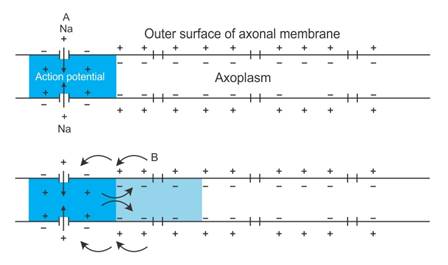

Q87. The receptor absent in the tongue is
Solution
Thermoreceptors (for temperature) and gustatoreceptors (for taste) are present in the tongue. Photoreceptors (for light) are present in the eye but absent in the tongue.
Q88. Name the three ossicles present in the
ear.
Solution
Three ossicles present in the ear are
malleus, incus and stapes.
Q89. Name the two structures of the external
ear and state their functions.
Solution
The two structures of the external ear
are pinna and external auditory meatus.
The pinna collects vibrations from the
surroundings to generate sound.
The external auditory meatus connects
the pinna to the tympanic membrane and carries vibrations to the tympanic
membrane.
Q90. Name the ridge of the ampulla which is projected and contains hair cells.
Solution
Crista ampullaris
Q91. Draw a well-labelled diagram showing the
sectional view of the cochlea.
Solution
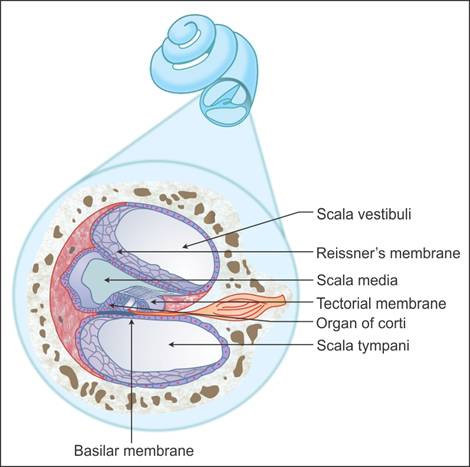
Q92. How many sodium ions move outwards per
two potassium ions during the conduction of nerve impulse?
Solution
Three sodium ions
Q93. Where is the endolymph present?
Solution
Endolymph is present in the membranous
labyrinth and the scala media of cochlea.
Q94. Name the pigment spot present at the posterior pole of the eye.
Solution
Macula lutea
Q95. Name the space between the cornea and
the lens.
Solution
Aqueous chamber
Q96. Name the two photoreceptor cells present
in the eye.
Solution
Rods and cones
Q97. Resting membrane potential is maintained by
Solution
The resting membrane potential is maintained by a sodium-potassium pump.
Q98. Explain the conduction of the nerve impulse at a chemical synapse.
Solution
Pre-synaptic and post-synaptic neurons are separated from each other by a synaptic cleft filled with a fluid.
 When the impulse reaches the axon terminal of the pre-synaptic neuron, it stimulates the movement of synaptic vesicles containing neurotransmitters towards the axon terminal to fuse with the plasma membrane.
When synaptic vesicles fuse with the plasma membrane, they release neurotransmitters.
These neurotransmitters travel through the synaptic cleft and bind to the receptors present on the post-synaptic membrane.
This binding opens the channels on the post-synaptic membrane which allows the entry of ions.
The entry of ions into the post-synaptic neuron generates a new potential.
When the impulse reaches the axon terminal of the pre-synaptic neuron, it stimulates the movement of synaptic vesicles containing neurotransmitters towards the axon terminal to fuse with the plasma membrane.
When synaptic vesicles fuse with the plasma membrane, they release neurotransmitters.
These neurotransmitters travel through the synaptic cleft and bind to the receptors present on the post-synaptic membrane.
This binding opens the channels on the post-synaptic membrane which allows the entry of ions.
The entry of ions into the post-synaptic neuron generates a new potential.
 When the impulse reaches the axon terminal of the pre-synaptic neuron, it stimulates the movement of synaptic vesicles containing neurotransmitters towards the axon terminal to fuse with the plasma membrane.
When synaptic vesicles fuse with the plasma membrane, they release neurotransmitters.
These neurotransmitters travel through the synaptic cleft and bind to the receptors present on the post-synaptic membrane.
This binding opens the channels on the post-synaptic membrane which allows the entry of ions.
The entry of ions into the post-synaptic neuron generates a new potential.
When the impulse reaches the axon terminal of the pre-synaptic neuron, it stimulates the movement of synaptic vesicles containing neurotransmitters towards the axon terminal to fuse with the plasma membrane.
When synaptic vesicles fuse with the plasma membrane, they release neurotransmitters.
These neurotransmitters travel through the synaptic cleft and bind to the receptors present on the post-synaptic membrane.
This binding opens the channels on the post-synaptic membrane which allows the entry of ions.
The entry of ions into the post-synaptic neuron generates a new potential.
Q99. In frog, "fenestra ovalis" is
Solution
"Fenestra ovalis" is an oval aperture through which tympanic cavity is connected with auditory capsule which houses the internal ear.
Q100. When is the sensation of white light produced?
Solution
When the cones responsible for different colours are stimulated equally, white light is produced.
Q101. How is the action potential achieved by a neuron?
Solution
When a stimulus is received by the axon which is in the resting potential at certain site, say at site A, the axonal membrane becomes freely permeable to Na+ ions.
This causes the rapid influx of Na+ ions which makes the outer surface of the membrane negatively charged, and the axoplasm is positively charged.
The changes in the permeability of the membrane and influx of Na+ ions reverse the polarity of the membrane, and thus, the action potential achieved by the axon.
Q102. Name the layer of cranial meninges which
is in direct contact with the brain tissue.
Solution
Pia mater
Q103. In mammals, the brain centre which
regulates body temperature is situated in the
Solution
In mammals, the hypothalamus maintains
homeostasis, i.e. it regulates body temperature.
Q104. Differentiate between aqueous chamber
and vitreous chamber.
Solution
Aqueous Chamber
Vitreous Chamber
It
is the space between the cornea and the lens.
It
is the space between the lens and the retina.
It
is filled with a fluid called the aqueous humour.
It
is filled with the vitreous humour.
Q105. Differentiate between myelinated nerve fibres and non-myelinated nerve fibres.
Solution
Myelinated Nerve Fibres
Non-myelinated Nerve Fibres
These nerve fibres have a myelinated sheath made of Schwann cells.
These nerve fibres are enclosed by Schwann cells, but they do not form a myelinated sheath around the nerve fibres.
They are found in spinal and cranial nerves.
They are found in the autonomic and somatic nervous systems.
Q106. What is the significance of the corpus
callosum?
Solution
The corpus callosum connects the two
cerebral hemispheres.
Q107. Which part of the human brain is the largest?
Solution
The cerebrum or cerebral hemisphere
forms the largest part of the brain. It constitutes four-fifths of the brain weight.
Q108. Name the photosensitive compounds
present in the photopigments.
Solution
The photosensitive compounds present in
the photopigments are
Opsin - a protein and retinal (an
aldehyde of vitamin A).
Q109. What is the other name for the ear drum?
Solution
The other name for the ear drum is tympanic
membrane.
Q110. Name the pigment present in the
photopigments.
Solution
Opsin
Q111. Name the canal which passes through the midbrain.
Solution
Canal aqueduct
Q112. Protein found in the eye lens is
Solution
Crystallin is a water-soluble protein present in the eye lens and cornea of the eye.
Q113. Name the two structures of the brain which form the limbic system.
Solution
Amygdala and hippocampus
Q114. Differentiate between rods and cones.
Solution
Rods
Cones
Rods
are responsible for daylight and colour vision.
Cones
are responsible for the twilight or scotopic vision.
Rods
contain a purple-red pigment called rhodopsin.
Cones
contain a pigment called iodopsin.
Q115. Name the ossicle to which the tympanic
membrane is attached.
Solution
Malleus
Q116. What are the two nerve fibres of PNS?
Solution
The two nerve fibres of PNS are
Afferent
fibres
Efferent
fibres
Q117. Name the cells which form a myelinated
sheath around a myelinated nerve fibre.
Solution
Schwann cells
Q118. Distinguish between axon and dendrite.
Solution
Axon
Dendrite
It
is the longest fibre given out by the cell body of a neuron.
Dendrites
are small branches given out by the cell body.
It
carries impulses away from the cell body.
It
carries impulses towards the cell body.
Q119. Define
coordination in living organisms. Why is it necessary? Give any one example.
Solution
Coordination
is the process in which one or more tissues or organs interact and complement
the function of each other to maintain the homeostasis of the body.
During
physical exercise, there is always increased energy demand. To fulfil this
demand, the supply of oxygen to the cells in concern increases. To provide
more oxygen, our respiration rate, heartbeat and blood flow increase.
Q120. What are synapses?
Solution
Synapses are the nerve junctions at
which nerve impulses are transmitted from one neuron to another neuron.
Q121. Draw a well-labelled diagram to explain
the transmission of the nerve impulse at a synapse.
Solution
Transmission of nerve impulse at synapse:


Q122. Describe the mechanism of the formation
of vision or image.
Solution
The light rays of the visible length are
focused on the retina through the cornea and the lens.
This light generates impulse in the rods
and cones which contain photosensitive pigments composed of opsin and
retinal.
The light brings about the dissociation
of retinal from opsin which brings about changes in the structure of opsin.
The change in the structure of opsin
causes changes in membrane permeability which generates an action potential
in the ganglion cells through the bipolar cells.
Once the change in action potential is
transmitted to the brain through the optic nerve, the brain sends the signals
back to the eye forming the image of the retina.
Q123. Name the region where the cone cells are
densely packed.
Solution
At the fovea, the cone cells are densely
packed.
Q124. Name the two main divisions of the
peripheral neural system.
Solution
Two main divisions of the peripheral
neural system are
Somatic
neural system
Autonomic
neural system
Q125. Name the middle layer of the cranial
meninges.
Solution
Arachnoid
Q126. Name the structure which connects the
middle ear and the pharynx. Also state its function.
Solution
The Eustachian tube connects the middle
ear and the pharynx. It equalises the pressure on either side of the tympanic
membrane or the ear drum.
Q127. Draw a well-labelled diagram of the sagittal
section of the human brain.
Solution
Human brain:


Q128. Draw a labelled diagram of a neuron.
Solution
Neuron:
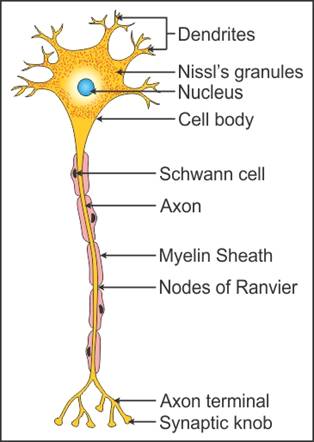

Q129. Cornea transplantation is outstandingly successful
because
Solution
Cornea is non-vascular. So, its transplantation is
successful.
Q130. In which parts of the neural system are
the myelinated nerve fibres found?
Solution
Spinal and cranial nerves
Q131. Eyes are the most important sense organs
in animals without which it would have been difficult to experience the
beauty of life.
Name
the photoreceptor cells and their pigments present in the retina.
Name
the compounds present in the photopigments.
State
the functions of rods and cones.
What
values do you learn from questions (a) and (c)?
Solution
Cones and rods. Iodopsin is present in cone
cells, and rhodopsin is present in rid cells.
Opsin and retinal are present in photopigments.
Rod cells are responsible for coloured and
daylight vision, while cones are responsible for twilight vision.
In team work, to achieve success in any task, synchronisation
in the work of team members is of utmost importance.
Q132. Name the granular bodies present in the
cytoplasm of neurons.
Solution
Nissl’s granules
Q133. Draw a labelled diagram of the ear.
Solution
Ear:
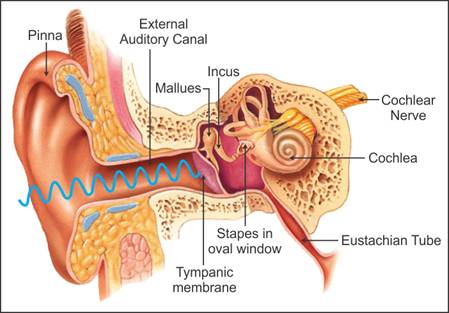

Q134. Write the significance of the autonomic
neural system.
Solution
The autonomic neural system transmits
nerve impulses from the central neural system to the involuntary organs and
smooth muscles of the body.
Q135. Which types of neurons are found in the
retina of the eye?
Solution
Bipolar neurons
Q136. State the significance of the cone
cells.
Solution
Cone cells are responsible for colour
vision and photopic vision.
Q137. Name the three cells present in the retina of the eye.
Solution
Three cells present in the retina of the eye are ganglion cells, bipolar cells and photoreceptor cells.
Q138. Name the structures which constitute the vestibular apparatus.
Solution
Semicircular canals and the otolith organ constitute the vestibular apparatus.
Q139. State
the two main parts of the human neural system.
Solution
Two
main parts of the human neural system are
Central
Neural System (CNS)
Peripheral
Neural System (PNS)
Q140. Name the region of the brain responsible
for controlling body temperature.
Solution
Hypothalamus
Q141. At the action potential, what charge is
present on the inner surface of the axonal membrane?
Solution
Positive charge
Comments
Post a Comment